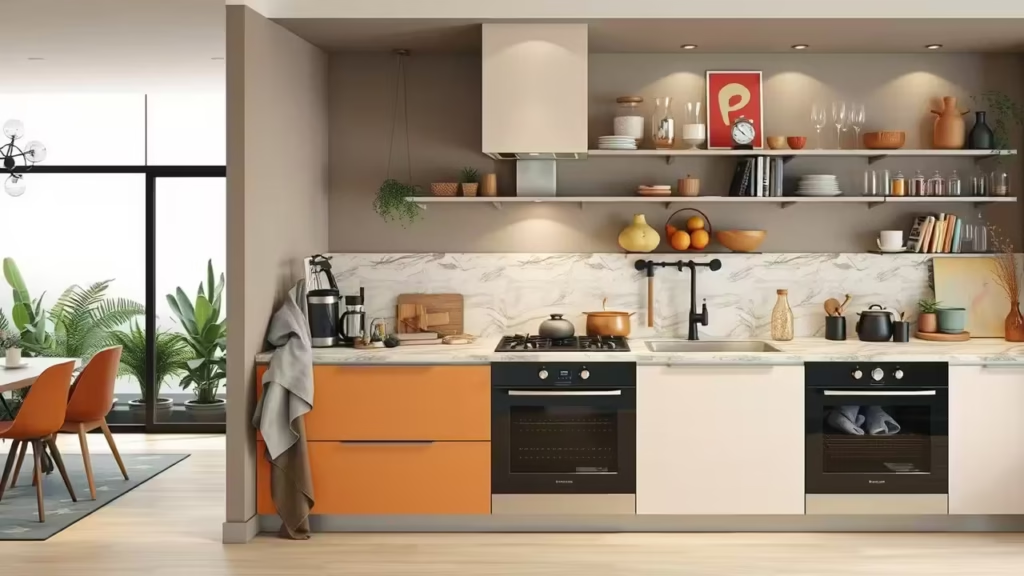Integrated Living room: A Concept for Families
Integrated living rooms have become increasingly popular, especially among families with young children. This design combines the living room, dining area, and sometimes the kitchen into one open space, promoting interaction and a sense of togetherness. Modern homes emphasize communication and shared experiences, making this approach ideal for families.
An integrated layout provides parents with better supervision of their children. By merging spaces, adults can easily monitor kids while cooking, working, or relaxing. This setup enhances safety and offers parents peace of mind. Additionally, the open design fosters a warm, welcoming atmosphere, encouraging family unity as children play freely and adults enjoy quality time together.
Creating an integrated living space meets both aesthetic and practical needs, making it a perfect choice for families with young children.

Open Spaces: Fluidity for Family Life
Open spaces in interior design eliminate physical barriers, creating a seamless flow essential for family life. This layout promotes interaction, allowing parents to engage with their children while managing daily tasks. Families benefit from the flexibility to define specific zones using furniture and rugs, optimizing the space for play and relaxation.
For example, L-shaped sofas or open shelves can separate areas without disrupting the openness. Rugs provide safe, comfortable play zones for children. Such arrangements enhance functionality and allow families to adapt the space to their evolving needs. Open layouts also improve light and airflow, creating a welcoming environment that fosters connection and well-being.
Visual Continuity: Harmony in Design
Visual continuity connects areas in an integrated living room through consistent colors, textures, and materials. A coordinated palette, such as soft neutral tones, creates a cohesive look and enhances spaciousness. Natural materials like wood and fabric add warmth, making the environment both practical and inviting.
This continuity supports supervision, as open sightlines allow parents to monitor children easily. Furniture arrangement and material choices enhance aesthetics while maintaining functionality, encouraging family interactions and a harmonious living space.

Visual continuity connects areas in an integrated living room through consistent colors
Functional Furniture: Enhancing Everyday Life
Functional furniture transforms integrated living rooms into practical, organized spaces. Modular sofas, for instance, adapt to various needs, offering extra seating or storage for toys and blankets. Their easy-to-clean surfaces make them ideal for families with young children.
Kitchen islands serve as multipurpose hubs, allowing parents to prepare meals while engaging with their kids. These pieces not only optimize space but also strengthen family bonds, ensuring a harmonious and organized home.
Strategic Lighting: Defining Spaces
Lighting plays a crucial role in integrated living rooms, helping define zones and enhance functionality. By using different light intensities, families can create specific areas for play, reading, or relaxation. For instance, warm lighting in play areas makes them inviting, while brighter lights in work zones boost focus.
Floor lamps, wall sconces, and dimmers offer flexibility, allowing families to adjust the ambiance as needed. Thoughtful lighting design creates a multifunctional, cozy space that supports family interaction and well-being.
Decorative Elements: Personalizing the Space
Decorative elements personalize integrated living rooms while maintaining practicality. Plants, for example, add freshness and improve air quality. Families should choose safe, low-maintenance species and place them out of children’s reach.
Open shelving combines organization with display, using baskets for toys and durable, child-friendly decor. Thoughtfully chosen decorations enhance the space’s aesthetic and functionality, creating a welcoming environment for all family members.
The Integrated Living Room: Adapting to Family Lifestyles
Integrated living rooms address the needs of modern families by fostering interaction and flexibility. Parents can prepare meals while keeping an eye on children, ensuring safety and connection. Furniture and layout adaptability allow families to optimize space without sacrificing comfort.
This design also promotes emotional well-being by eliminating barriers and encouraging togetherness. An integrated living room not only meets functional requirements but also creates a nurturing environment for family growth and happiness.

Benefits for Social Gatherings
Integrated living rooms enhance social gatherings by providing open, versatile spaces that encourage interaction. Guests can comfortably connect in one area, while parents easily supervise children. Flexible layouts accommodate various events, making integrated living rooms ideal for families who enjoy hosting.
By blending practicality and aesthetics, integrated living spaces offer families a harmonious and adaptable home environment.

Integrated and comfortable living room that adapts to receiving friends. Photography of Daria Shevtsova
Conclusion: The Integrated Living Room as a Family Solution
The integrated living room presents itself as an exceptional solution for families with young children, offering multiple benefits that impact both the functionality of the home and the overall well-being of its members. The openness of the spaces, a key feature of this design, allows parents and children to interact in a more natural and fluid way, which is crucial for the emotional and social development of children. Additionally, by removing physical barriers, family cohesion is fostered, promoting shared moments that are vital for strengthening family bonds.
The design of an integrated living room not only addresses functionality but also attends to the home’s aesthetics. This approach allows for the creation of a harmonious and warm environment, where colors, lighting, and furniture arrangement work together to form a space that invites togetherness. For example, by choosing versatile furniture and cozy decor, a balance between practicality and attractiveness is achieved, which is fundamental in a home where children are an active part of daily life.
Furthermore, the integrated living room contributes to better space organization, making it easier to supervise children while engaging in various activities, from play to homework. This not only increases safety but also allows parents to maintain better control over the family environment. In summary, this design combines functionality and aesthetics, optimizing space usage and enhancing the quality of life for the entire family. Therefore, it is a seriously worthwhile alternative for families looking for a more dynamic and welcoming home.
Summary of Benefits
- Simplified supervision: Monitor children effortlessly while multitasking.
- Enhanced interaction: Open spaces foster family bonding.
- Flexible layouts: Adapt to changing needs with versatile furniture.
- Improved ambiance: Lighting and design create inviting environments.
- Practical decor: Blend style and functionality to suit your family.
Transform your home with an integrated living room and enjoy a space that supports connection, growth, and harmony for your entire family.
